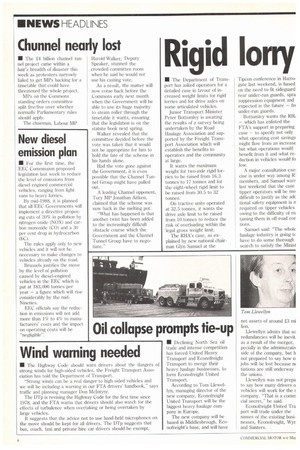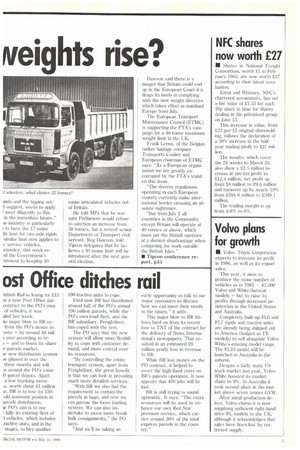Rigid lorry !nights rise?
Page 4

Page 5

If you've noticed an error in this article please click here to report it so we can fix it.
• The Department of Transport has asked operators for a detailed case in favour of increased weight limits for rigid lorries and for drive axles on some articulated vehicles.
Junior Transport Minister Peter Bottomley is awaiting the results of a survey being undertaken by the Road Haulage Association and supported by the Freight Transport Association which will establish the benefits to operators and the community at large.
It wants the maximum weight for two-axle rigid lorries to be raised from 16.3 tonnes to 17 tonnes and for the eight-wheel rigid limit to be raised from 30.5 to 32 tonnes.
On tractive units operated at 32.5 tonnes, it wants the drive axle limit to be raised from 10 tonnes to reduce the risk of overloading within the legal gross weight limit.
The RHA's case, as explained by new national chairman Glyn Samuel at the Tipcon conference in Harrogate last weekend, is based on the need to fit sideguard. rear under-run guards, spra suppression equipment and expected in the future — frt under-run guards.
Bottomley wants the RH/ — which has enlisted the ETA's support in preparing case — to specify not only what operating cost savings might flow from an increase but what operations would benefit from it and what reduction in vehicles would fo low.
A major consultation exei cise is under way among R1 members, and Samuel wart last weekend that the case tipper operators will be mo difficult to justify as the adc tional safety equipment is n required on tipper vehicles owing to the difficulty of nit taming them in off-road con tions.
Samuel said: "The whole haulage industry is going tc have to do some thorough search to satisfy the Minist
ands and the tipping secI suggest, needs to apply f most diligently to this in the immediate future." le industry is particularly to have the 17 tonne ;ht limit for two-axle rigids similar limit now applies to 'lc service vehicles. Atomley, this week reed the Government's -nitment to keeping 40
tonne articulated vehicles out of Britain.
He told MPs that he was sure Parliament would refuse to sanction an increase from 38 tonnes, but a retired senior Department of Transport civil servant, Reg Dawson, told Tipcon delegates that he believes a 40 tonne limit will be introduced after the next general election. Dawson said there is a danger that Britain could end up in the European Court if it drags its heels in complying with the new weight directive which takes effect in mainland Europe from July.
The European Transport Maintenance Council (ETMC) is supporting the FTA's campaign for a 40 tonne maximum weight limit in the UK.
Frank Lemo, of the Belgian tanker haulage company Transports Coulier and European chairman of ETMC says: "As a European organisation we are greatly encouraged by the FTA's stand on this issue.
"The diverse regulations operating in each European country currently make international border crossing an absolute nightmare.
"But from July 1 all countries in the Community except Britain will operate at 40 tonnes or above, which must put the British operator at a distinct disadvantage when competing for work outside the British Isles."
• Tipcon conference report, p31














































































